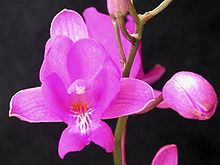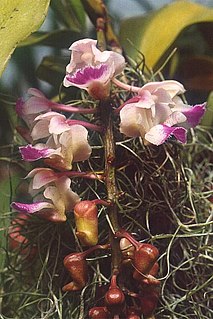
In the botanical classification of plants, Aeridinae is a subtribe of the Tribe Vandeae whose representatives all have a monopodial growth habit and do not possess pseudobulbs.
The taxonomy of the Orchidaceae has evolved slowly during the last 250 years, starting with Carl Linnaeus who in 1753 recognized eight genera. De Jussieu recognized the Orchidaceae as a separate family in his Genera Plantarum in 1789. Olof Swartz recognized 25 genera in 1800. Louis Claude Richard provided us in 1817 with the descriptive terminology of the orchids.. The next step was taken in 1830-1840 by John Lindley, who recognized four subfamilies. He is generally recognized as the father of orchid taxonomy. The next important step was taken by George Bentham with a new classification, recognizing subtribes for the first time. This classification was first presented in a paper that Bentham read to the Royal Society in 1881. Then it was published in 1883 in the final volume of Genera Plantarum. The next great contributors were Pfitzer (1887), Schlechter (1926), Mansfeld (1937), Dressler and Dodson (1960), Garay, Vermeulen (1966), again Dressler (1981). and Burns-Balogh and Funk (1986). Dressler's 1993 book had considerable influence on later work.

Epidendroideae is a subfamily of plants in the orchid family, Orchidaceae. Epidendroideae is larger than all the other orchid subfamilies together, comprising more than 15,000 species in 576 genera. Most epidendroid orchids are tropical epiphytes, typically with pseudobulbs. There are, however, some terrestrials such as Epipactis and even a few myco-heterotrophs, which are parasitic upon mycorrhizal fungi.

Xerorchis is an orchid genus in the subfamily Epidendroideae, and the sole representative of tribe Xerorchideae. This is a very primitive genus consisting of terrestrial orchids. Xerorchis thrives in South America.

Phyllanthaceae is a family of flowering plants in the eudicot order Malpighiales. It is most closely related to the family Picrodendraceae.

Chysis is a genus of orchids, consisting of 10 currently accepted species which originate in the region from Mexico to Peru. Only two or three of these are commonly found in cultivation. The genus is abbreviated Chy in trade journals.

Coelia is a genus of orchids. It had previously been tentatively classified as the only genus of the subtribe Coeliinae of the tribe Epidendreae.

Laeliinae is a Neotropical subtribe including 40 orchid genera, such as Brassavola, Laelia and Cattleya. The genus Epidendrum is the largest within this subtribe, containing about 1500 species. This is followed by the genus Encyclia, with over 120 species.

Arethuseae is a mid-sized tribe of orchids in the subfamily Epidendroideae. This tribe was initially categorized by John Lindley in 1840. Its largest subtribes are Arethusinae and Coelogyninae.

The Vandeae is a large monophyletic tribe within the family of orchids.
Ponerinae is a subtribe of the Orchidaceae tribe Epidendreae. The Ponerinae are characterized by sympodial stems that do not form pseudobulbs, bear two or more leaves, and a racemose or paniculate inflorescence carrying flowers with four or six pollinia.
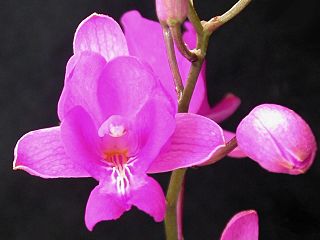
The tribe Epidendreae of the Orchidaceae comprises six subtribes:
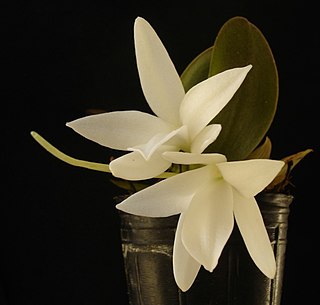
Aerangidinae is classified as a subtribe within the tribe Vandeae in the family Orchidaceae. However, it is likely to soon become a synonym of Angraecinae with the genera below re-allocated to this sub-tribe. As traditionally circumscribed, it consists of 36 genera and about 300 species. The type genus of this subtribe is Aerangis. Members of this group are epiphytic orchids having a monopodial habit and are endemic to tropical Africa and Madagascar. They are distinguished from the other subtribes in Vandeae by having an elongate rostellum, an elongate spur, and two pollinia. Most genera in the group indicate pollination by moths, however leaf beetles are reported as frequent visitors, but it is unknown whether they are vectors for pollination.

The Eriinae form a subtribe of Podochileae, a tribe of the orchid family (Orchidaceae). The name is derived from the genus Eria.

Dendrobieae is a tribe in the subfamily Epidendroideae, in the family Orchidaceae.
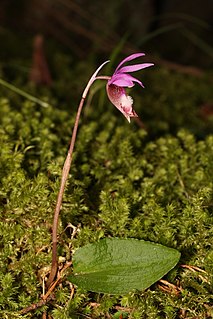
Calypsoinae is an orchid subtribe in the tribe Epidendreae of subfamily Epidendroideae. It has previously been recognized as tribe Calypsoeae in the subfamily Epidendroideae.

Eulophiinae is an orchid subtribe in the tribe Cymbidieae. It comprises 270 species divided into nine genera, with the genus Eulophia comprising 60% of these species.

Malaxidinae is an subtribe of orchids in the tribe Malaxideae of the subfamily Epidendroideae.
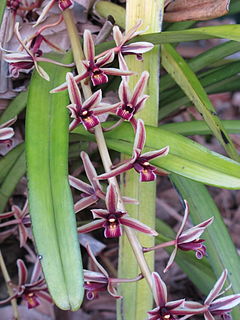
Cymbidiinae is an orchid subtribe in the tribe Cymbidieae.
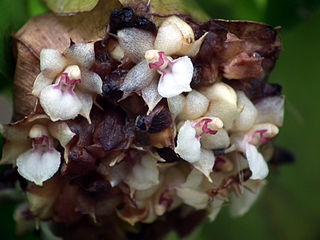
Agrostophyllinae is an orchid subtribe in the tribe Epidendreae.
